Who was John Ruskin?
John Ruskin was a famous artist, and writer, art critic of the Victorian era, and was born on February 8, 1819, in London, England. He was born to a noble family where his father – John James Ruskin was a wealthy Scots wine merchant. John James Ruskin was the founding partner of Pedro Domecq sherries- the well known Sherry wine traders.
Art
He was an art collector himself which is why he encouraged his son to appreciate art and culture. His mother – Margaret Ruskin was a devout Protestant and a dedicated Bible reader who submitted her early life in the service of God. She very much wanted her only son John Ruskin to become an Anglican Bishop and raised him with thorough bible values and morals.
This mixture of artistic excitement and Christian values laid the foundation of Ruskin’s later perception of life.
Early Life of John Ruskin
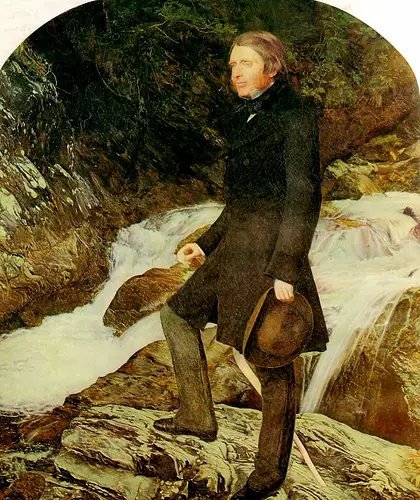
As a child, Ruskin was reserved. He was given his education at home until the age of 12. During the sixth year, he travelled to Europe with his parents. This gave him an opportunity to have a peek at the newly forming high classes and middle classes of the society.
In these years famous painters such as JMW Turner, John Constable, and John Cotman were at the making the careers. Ruskin’s father, an Art Enthusiast would collect these paintings and these beautiful artworks would inspire and ignite John Ruskin.
On the other hand, religious preachers such as Charles Simeon, John Keble, Thomas Arnold were establishing spiritual concentration that was somehow characterizing the reign of Queen Victoria.
At the minor age of 11, John Ruskin published his first poem “On Skiddaw and Derwent Water,” as a result of his fathers heartening. Four years later, his prose work, which was a simple article on the waters of the Rhine was published.
List of his Paintings
Lion’s profile
View of Amalfi
Self Portrait with Blue Neckcloth
River Seine and its Islands
Falls of Schaffhausen
Rocks in Unrest
Fribourg Suisse
Zermatt
Since Ruskin was from a wealthy family, he had the luxury to travel across countries and see paintings, landscape, and buildings all over Britain and other European countries.
In the 1830’s Ruskin started publishing pieces of prose in magazines. He discovered the works of JMW Turner in 1833. During this time, he started writing the “Modern Painters” – Volume 1 and defended Turner’s work from the art critics at “Blackwoods Magazine”. He won the Newdigate Prize for poetry from the University of Oxford where he studied for five years.
However, Ruskin failed to sit for the honours degree due to his bad health. He returned to the University in the year 1842 and continued his vindication for Turner’s works. By this time he completed the second volume of “Modern Painters” in which he discussed his own views on the beauty and imagination within the context of landscape and figural paintings.
Art Criticism by John Ruskin
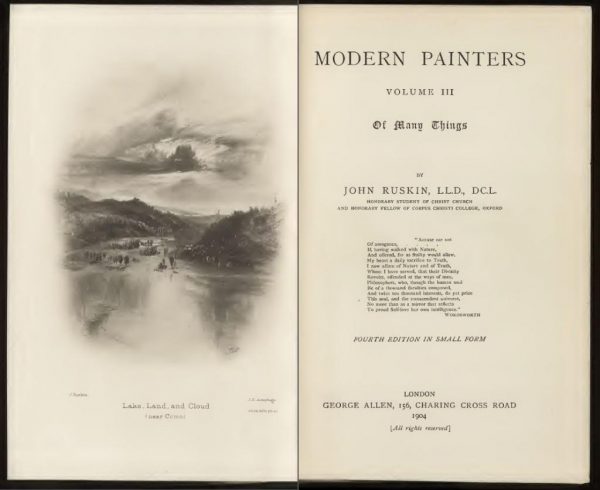
Ruskin had no idea that the “Modern Painters” would occupy him for the next 17 years. He published it in five volumes focusing on the ‘truth’ in Turners works and landscape paintings. Turner’s paintings were based on his interests in biology, botany, and geology.
The Neoclassical writers attacked Turner by writing negatively about his progressive mimetic paintings calling them inaccurate, but John Ruskin continually defended Turner by declaring the fact that “general truth” depiction must happen in art form too.
One after another, Turner’s “truth of tone,” “truth of colour,” “truth of space,” “truth of skies,” “truth of earth,” “truth of water,” and “truth of vegetation” were depicted and studied from his paintings. The final volume of Modern Painters came out in 1860.

Ruskin successfully brought the assumptions in Romanticism to practice in art criticism. With this inspiration, other experimental and progressive painters like Turner worked in a new spirit.
Through Ruskin’s writings, the new wealthy commercial classes of the English Society developed an interest in collecting art and appreciating the beauty in landscape paintings and paying a price for the same. He defined painting as “a noble and expressive language, invaluable as the vehicle of thought, but by itself nothing.”
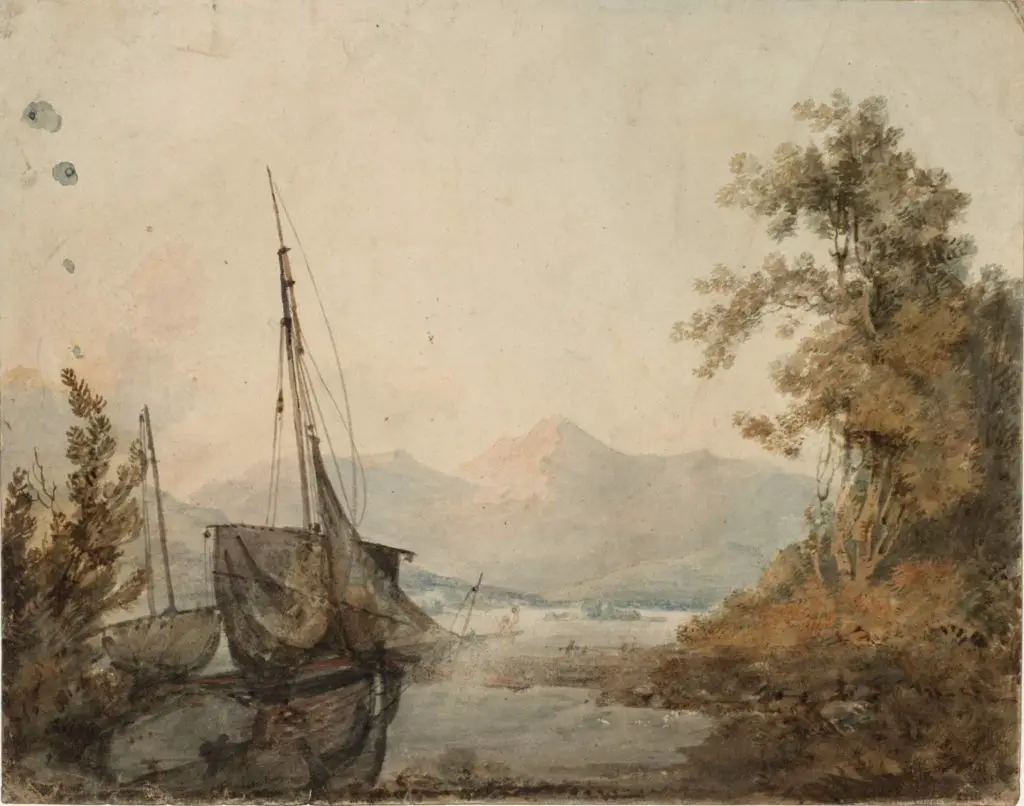
In 1846, the third volume of Modern Painters came out wherein Ruskin spoke about the difference between theory and ethics in the art from the creative and aesthetic yet not informative or non-scholastic form of art.
Even though Ruskin maintained good friendly relationships with painters of aesthetics, Ruskin would stand by his views on a theoretical form of art all his life.
John Ruskin’s Marriage
Euphemia Chalmers Gray
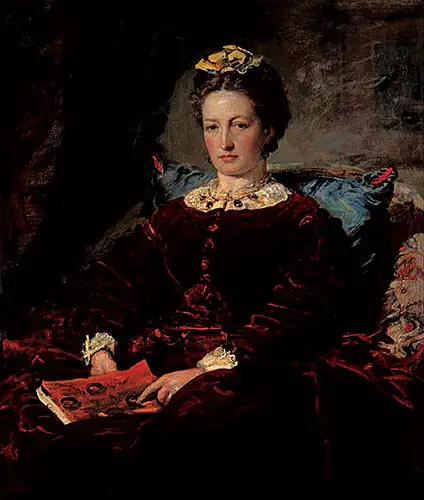
(born on 7 May 1828 in Perthshire, Scotland and died on 23 December 1897 in Perthshire, Scotland.)
The Ruskins had a healthy and cordial relationship with the family of the Grays. The families often encouraged a match between John Ruskin and the Grays daughter – Euphemia Chalmers Gray. John was already very fond of her, when she was twelve Ruskin wrote her the fantasy novel – King of the Golden River in 1841.
They were married in 1848, after which they took a tour to Venice where Ruskin could study upon his novel – The Stones of Venice. However, this marriage did not last long due to the differences in opinions and perceptions of the couple.
For instance, in Venice Euphemia saw this travel as a chance to socialize and mate with other people but Ruskin engaged himself in studying art and architecture, research and making newsletters.
Euphemia, quite unhappy with this marriage, after five years, met the painter – John Everett Millais. Earlier Ruskin was a supporter of his work. However, as Millais’s paintings took a broader turn, Ruskin condemned it as “catastrophe”. Euphemia modelled for Millais’s painting – The Order of Release where she portrayed the wife of a rebellious Scottish prisoner.
This is when they drew close and Euphemia got herself an annulment from her current marriage with John Ruskin and finally married John Everett Millais in the year 1855. After this, she was a huge supporter and promoter of her husbands’ work.
Art and Architecture (Critics) by John Ruskin
After his failed marriage, Ruskin involved himself in the discovery of the art and architecture of the Gothic Middle Ages. He wrote about the idealist Gothic painters such as Giotto, Fra Angelico, and Benozzo Gozzoli in the second volume of Modern Painters and added them in the updated version of the first volume in 1846.
According to Ruskin, they provided an inspiring art of the modern age back in Gothic times.
In 1851, Ruskin promoted the Pre Raphaelite Brotherhood (PRB), which was formed in 1848 to discourage Neoclassical assumptions in art schools across Europe. Ruskin published pamphlets and letters to the Times against their critics. He also recommended their work in his lecture at Edinburgh in 1853.
In 1848, Ruskin took a honeymoon with his wife Euphemia Gray (Effie Gray), when they visited Gothic churches of Northern France. Inspired by the architecture, Ruskin wrote the “The Seven Lamps of Architecture” where he laid down seven moral principles with respect to architecture. This was published in 1849. In 1851, the first volume of “The Stones of Venice” was published.
Two more volumes came out in 1853. The book is based on the intricate studying of buildings and churches across Venice and the artists behind them. It also points out the political medievalism found in the works of William Corbett and Robert Southey.
Ruskin’s writing played an important role in establishing the view that the architectural style of Venice, the great marine trading nation of the medieval world, was particularly appropriate for buildings in modern Britain. There also came out the second volume – The Nature of the Gothics wherein he pointed the beauty in the imperfection of Gothic Art.
Cultural Criticism
The death of John Turner in 1851 and the failure of John Ruskin’s marriage in 1854 led to the withdrawal of Ruskin from society. He dedicated all of his time to travel during the years 1856-1858. He voluntarily took up the duty of administrative works as the chief artistic officer of Turner’s estate.
He made a major contribution both physically as well as financially in the construction of a significant Gothic revival building: The Benjamin Woodward’s Oxford Library. He became a persuasive commentator on contemporary art depicted by his annual Academy notes. By 1858, Ruskin developed a deep friendly relationship with Thomas Carlyle, essayist, and historian. Like Carlyle, Ruskin developed a prophetic stance, reflecting on the Bible.
In 1858, he lectured on – The Work of Iron in Nature, Art, and Policy which was later published in the book – The Two Paths in 1859. This book shows how Ruskin connected the theories of art in his economic life. In the 1860s, Ruskin published his works- “Unto His Last” and “Munera Pulveris” where he was highly critical of the capitalist economists of his times.
Ruskin lost his father in the year 1864 which left him very wealthy. He used his capital in the contribution to idealistic social causes notably the pastoral community of Guild, St. George which was formally built-in 1878.
In 1866, Ruskin fell in love with Rose la Tousche, a woman who was 30 years younger to him and suffered mental disorders which led to Ruskin’s acute depression. During this phase, he showed signs of psychological illnesses. Finally, in 1871, he bought a house in the English Lake District and lived there for the rest of his life. This house is now a museum of his work.
His last and major work was his autobiography – “Praeterita”. This book was unfinished and has no mention of his marriage whatsoever. Hence, chronologically, it is not very trusted. Although, it provides a memorable context for the growth of his distinctive personality.
Quotes
John Ruskin books
Here are some of his notable books.
Modern Painters 5 vols. (1843–1860)
The Seven Lamps of Architecture (1849) In Chapter nature of gothic he has given view on how society should be organised.
We want one man to be always thinking, and another to be always working, and we call one a gentleman, and the other an operative; whereas the workman ought often to be thinking, and the thinker often to be working, and both should be gentlemen, in the best sense. As it is, we make both ungentle, the one envying, the other despising, his brother; and the mass of society is made up of morbid thinkers and miserable workers. Now it is only by labour that thought can be made healthy, and only by thought that labour can be made happy, and the two cannot be separated with impunity
The Stones of Venice 3 vols. (1851–1853)
Unto This Last (1860, 1862)
Fors Clavigera (1871–1884)
Praeterita 3 vols. (1885–1889)
Death of John Ruskin
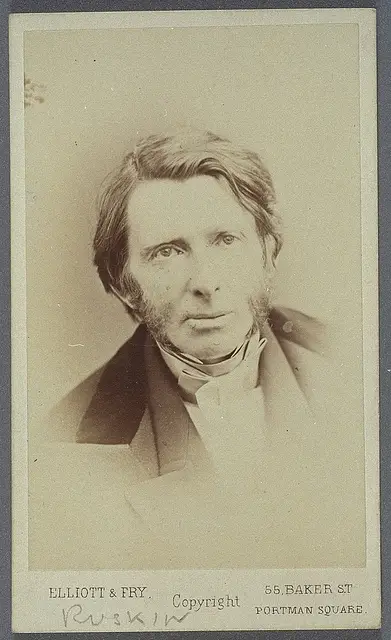
On 20th January 1900, Ruskin died of flu at the very old age of 80. His death occurred in his house, The Brantwood, United Kingdom. His contribution to English prose is immense. His works on architecture and his style of depicting socio-economic problems in the form of art are still referred to and also applauded till date.